Called Gulasch in German, guláš in Czech, and gulasz in Polish, it is great comfort food, not to mention the ideal beer grub.
 Traditional Hungarian goulash (Gulyásleves). |
At the annual Goulash festival in Szolnok, we tasted a number of excellent goulashes, including Székely Gulyás (pork goulash with sauerkraut), a bean goulash (no potatoes, kdiney beans instead), Likócsi Gulyás made of pork and thin vermicelli with a hint of lemon juice (almost like the Goulasch della Val Pusteria from north Italy), and Birkagulyás made of mutton and flavored with wine. All of these goulashes have one in common: they are soups.
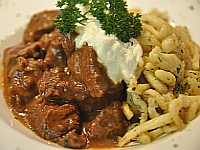 Vienna-style beef goulash with Spätzle. |
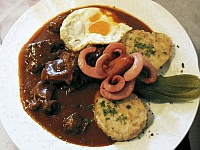 Viena Fiakergoulash served with dumplings and Sacher sausage. |
 A fiaker carriage. |
 Pörkölt served with potato gnocchi. |
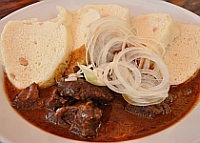 Vienna-style goulash from Prague, served with Czech dumplings. |
Goulash did not make it in the United States. Although there is a dish of that name first mentioned in cookbooks in 1914, goulash in America has evolved into something completely different. What is understood under "goulash" in America is a casserole made with ground beef and pasta. An Italian ragù milanese meets Texas chili con carne sort of a thing. The only connection with the Vienna Goulash or the Hungarian Goulash is the name, and the use of beef and paprika. Nothing else.
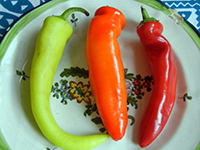 Red Hungarian peppers. |
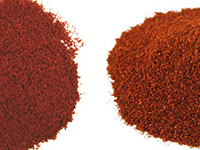 Ground Hungarian Paprika (left) vs. ground New Mexico Ancho Chile (right). |
Just like chile peppers in America, Hungarian paprika is also a world of its own.
It is available in grades ranging as follows:
- Különleges - the mildest, very sweet with a deep bright red color
- Csípősmentes csemege (Delicate) – color from light to dark red, a mild paprika with a rich flavor
- Csemegepaprika (Exquisite, Delicate) – similar to Delicate, but with slight heat
- Csípős Csemege, Pikáns (Hot, Exquisite Delicate) – a hotter version of Delicate
- Rózsa (Rose) – pale red in color with strong aroma and mild heat
- Édesnemes (Noble Sweet) – bright red with slight heat, still considered mild; this is the most commonly exported paprika, the typical Hungarian Sweet Paprika fround in American grocery stores
- Félédes (Half-Sweet) – A blend of mild and hot paprikas; medium heat
- Erős (Strong) – light brown in color, the hottest Hungarian paprika
 Hungarian paprika powder from Kalocsa. |
Terminology:
- Gulyás - a Hungarian cattle-herdsman
- Gulyásleves - Hungarian kettle goulash with soup-like consistency. It is made with peppers, braised meat, onions and paprika. Unlike the Viennese goulash, this dish is not thickened by flour and tastes quite light. Note that this is not what is known as "goulash". outside of Hungary. When the rest of the world eats "goulash", they eat Viennese goulash, which would be called "pörkölt" in Hungary.
- Pörkölt - Same ingredients as in Gulyás, but boiled down to a thicker consistency. "Goulash" to the rest of the world.
- Paprikás - Pörkölt made with chicken and thickened with sour cream.
- Wiener Saftgulasch (Viennese Goulash) - A savory stew consisting of even amounts of
chopped onions and meat (usually beef) cut into bite-size pieces, slowly braised with sweet and hot paprika powder,
salt, pepper, caraway, marjoram, garlic and tomato paste, thickened with flour.
Viennese goulash has a typical deep, dark color. Here are some of its varieties:
- Fiakergulasch - Viennese goulash garnished with fried Vienna sausage, fried egg and a pickle cut and spread into a fan, served with bread dumplings
- Prague Goulash - Same as Viennese goulash
- Znojmo Goulash - Viennese goulash with sweet-and-souor Znojmo pickles
- Zigeunergulasch - Viennese goulash using beef, pork or lamb, with diced tomatoes, potatoes and green peppers
- Esterházygulasch - Beef goulash with sour cream, capers and julienned carrots, turnips and celery root, served with boiled potatoes
- Karlsbad Gulasch - Beef goulash with sour cream served with gnocchi
- Kaisergulasch - Goulash of beef tenderloin or beef sirloin, served with noodles
- Andrássy Goulash - Beef goulash with halušky (spätzle) and bacon)
- Trieste Goulash - Viennese beef goulash served with polenta instead of dumplings
- Gulasch della Val Pusteria - Beef or pork goulash from South Tyrol in Italy, made not with the typical goulash seasonings, but with uniquely Italian ingredients such as oregano, rosemary and citrus peel, served with crusty white bread.
- Bean Goulash - A stew called Bableves in Hungary, prepared similar to the Potato Goulash except mixed beans are used in place of potatoes. Sounds a bit simialr to New Mexican Chili, except paprika is used instead of ground chile.
- Szeged Goulash - Pork stew with sauerkraut and sour cream.
- Debrecin Goulash - Goulash made with Debrecin sausage instead of meat.
- Potato Goulash - Goulash of chopped sausage (Braunschweiger or Kielbasa) and onions fried in hot fat, with paprika, cumin, salt and pepper, deglazed with vinegar, and cooked with chopped potatoes.
- Sausage Gulasch (Wurstgulasch, Buřt guláš) - Low-budget potato-and-sausage goulash with tomato sauce.
- Mushroom Gulasch - Low-budget goulash made with wild forest mushrooms instead of meat.
- Goulash po komunisticeski (Communist Goulash) - Kazakh goulash that uses any kind of meat, because, as our friend Vladimir once said, "during Communism only Communists had meat" :)
- We will tactfully omit the Hundguláš, a beggars' recipe for dog-meat goulash and leftover vegetables from 19th-century Prešporok (Bratislava).

Here are our collected favorite goulash recipes:

Goulash Gallery:
 Original Hungarian gulyás. |
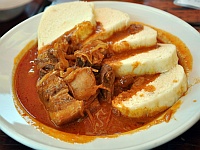 Szeged Goulash with Czech bread dumplings. |
 Vienna Goulash with Czech bread dumplings. |
 Feldkurat Katz Goulash (Vienna Goulash) at Schweik Restaurant in Prague. |
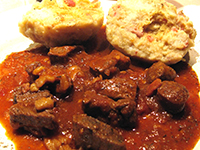 Our take on the Feldkurat Katz Goulash with bacon dumplings. |
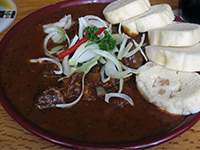 Vienna Goulash at Restaurace Pod Slavínem (this menu has not changed in 30 years!). |
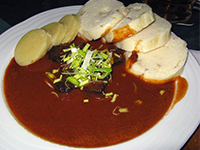 Vienna Goulash with Czech bread dumplings and potato dumplings. |
 Vienna Goulash with lard (bacon) dumplings. |
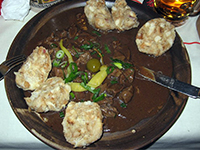 Vienna Goulash with lard (bacon) dumplings. |
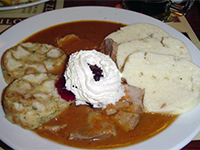 Pork goulash served with Czech bread dumplings (left) and raised dumplings (right). |
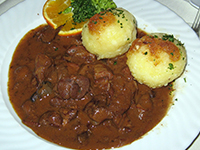 Goulash with Bavarian potato dumplings. |
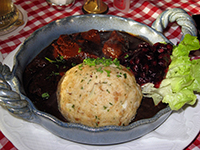 Deer goulash with Bavarian bread dumpling at Gasthof Hanselewirt in Schwangau. |

back to Radim and Lisa's Well-Travelled Cookbook | email us
Last updated: September 20, 2014
